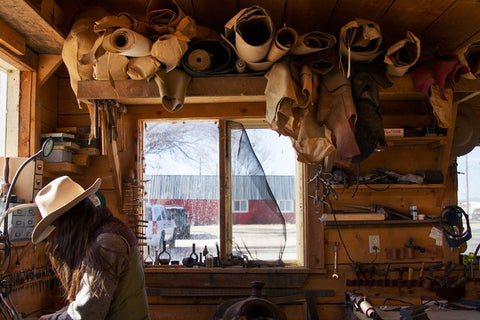Red wine and leather have more in common than you’d think. Both are made using tannins, a naturally-occurring molecule commonly found in plants that binds to proteins and results in varying levels of acidity. When you drink a glass of Malbec, the tannins from the grapes and the oak barrel leave a tart taste in your mouth. When you purchase a crossbody bag from our mercantile shop, the leather is dyed using oak, chestnut, or mimosa bark, and the tannins from these plants result in a longer-lasting vegetable tanned product.
The word “tan” comes from the Latin word “tannum,” meaning ‘oak bark’. People began making and tanning their own leather goods using a variety of plants as early as 7000 BCE. The vegetable tanning process has remained relatively unchanged since then; however, the addition of chrome tanning, a faster and cheaper tanning method, was created in 1858 to support a growing capitalist economy. Today, roughly ninety percent of the world’s leather products are chrome tanned, which typically only takes several days and uses harsh chemicals to dye the hide. Vegetable tanning can take anywhere from six weeks to six months, depending on the plants used and the number of “pits” or barrels the leather soaks in. Hides start in pits with lower concentrations of tannins and gradually move their way up to pits with stronger concentrations, the idea being the leather gets more resilient as it soaks and can handle this increase in astringency. At Ranchlands, we find vegetable tanning to be the best and most effective method because the leather not only develops a beautiful color but also lasts longer due to the natural tannins and lack of chemical additives that can often break down a hide faster. Plus, it’s an environmentally friendly option, using only what the natural world provides to dye the leather.
According to Madi Phillips, shop manager and lead product designer, vegetable tanned leather is tricky to work with at first, but with some practice, is far more rewarding and durable. Madi began working with vegetable tanned leather back in 2014 after Duke Phillips III, Ranchlands founder, asked her to make some headstalls for the ranch. “It was kind of intimidating because of how heavy-duty and unforgiving the leather is. It really shows marks and mistakes.” But the more Madi worked with it, the more she began to appreciate the skill involved. “You can see the character as you wet and mold and dye it. It’s denser and more difficult to cut through and shape than chrome or chap leather but it’s actually more versatile because of its durability and quality.” 
Take a peek in the Chico Basin saddle house and you’ll see headstalls and reins, in varying shades of brown and differing thicknesses, all made from vegetable tanned leather, and all holding up well despite years of rough wear. Andrea and Bri, two full-time shop artisans, find vegetable tanned leather is stiff enough to provide structure but with proper oiling and care will bend and break in over time. The light, cream color patinas into a rich, caramel-brown color with wear. It’s often used to make saddles, too, which arguably take the biggest beating of all ranch gear. After gathering enough field research, and adding several talented artisans to the team, the Ranchlands shop decided to incorporate vegetable tanned leather products into the line-up (the Crossbody Bag and Billie Bag are two of our favorite products from this heritage line). We still use chrome-tanned leather for certain products or parts of a design because it is significantly softer and provides a degree of flexibility. The Crossbody bag has a vegetable-tanned back panel and flap paired with a chrome-tanned and chap leather gusset. The softer chrome tanned leather allows the gusset to expand, so you can squish more stuff - ie books, moisturizer, binoculars - into your bag if need be.
The two American tanneries we source our vegetable tanned leather from are Horween and Hermann Oak. Horween was founded in 1905 and continues to be one of the oldest tanneries in the United States, still run by the Horween family in a five-story block long building on the north side of Chicago. Hermann Oak, based out of St. Louis, Missouri, originally began as a small operation to supply settlers traveling West with harness leather for their wagons. To this day, the company is committed to a traditional vegetable tanning process and even has an “environmental” page on its website detailing the tannins they use and their commitment to the reduction of chemical waste. At Ranchlands we believe our most important job is land stewardship. Our leather shop is an extension of this work, a craft to lean on during times of drought or weak cattle markets to ensure our ranches remain financially and ecologically viable. It’s important that we purchase hides from tanneries committed not only to quality but responsible stewardship, too. Stay tuned for a blog post in the coming weeks on these two old-school tanneries, but in the meantime, browse our line of bags, belts, and knife sheaths made with Herman Oak and Horween leather.


Leave a comment